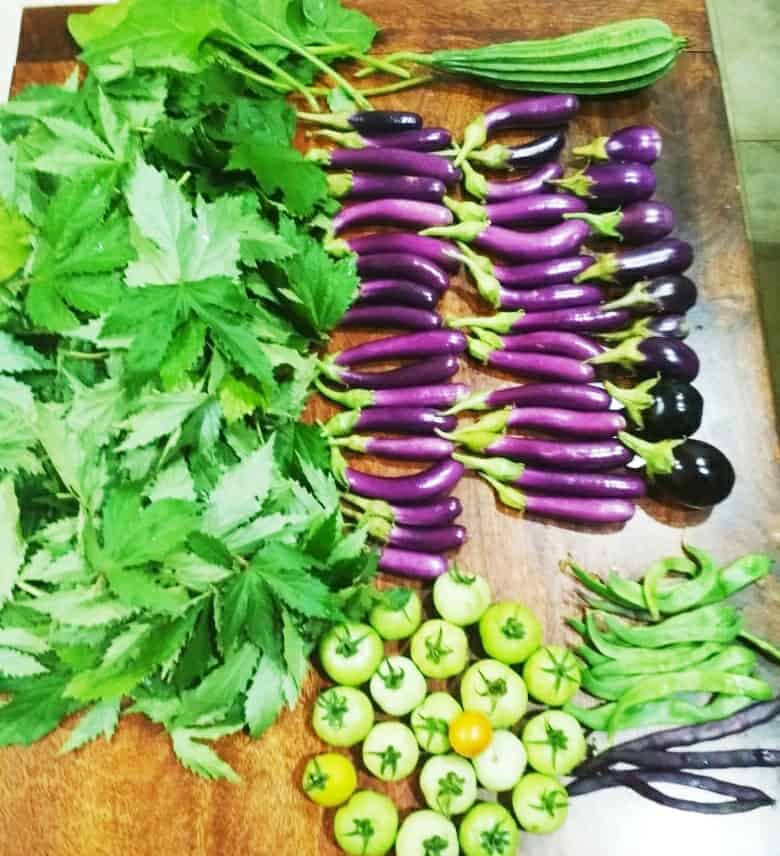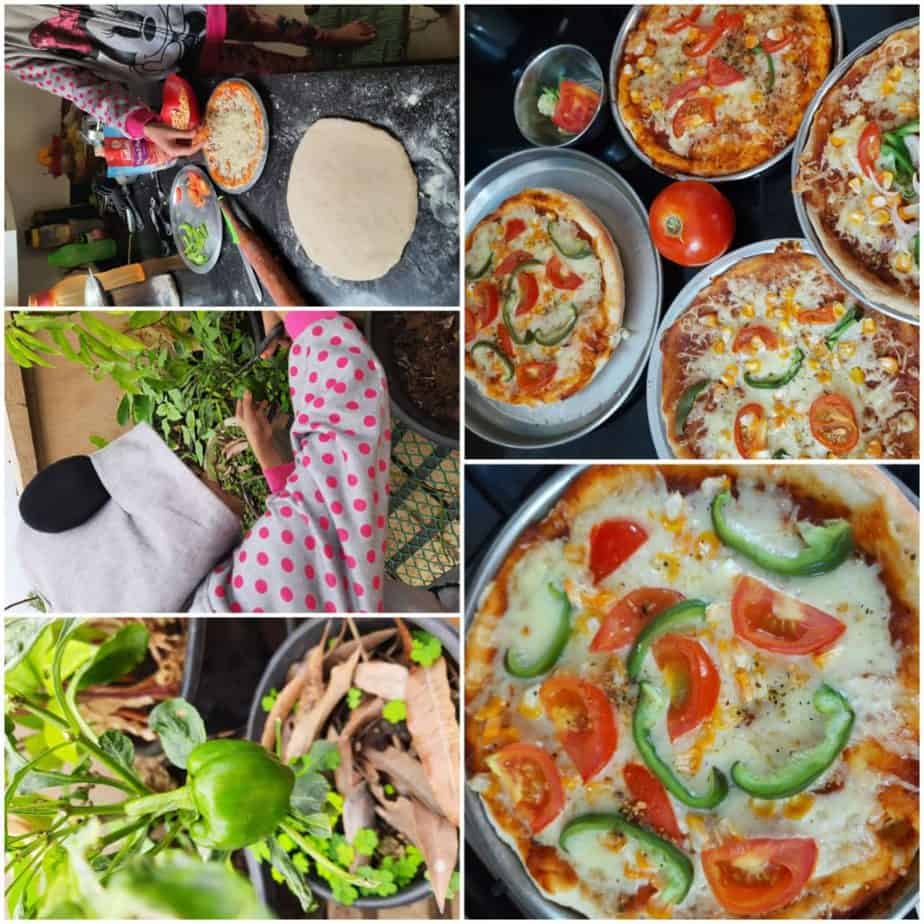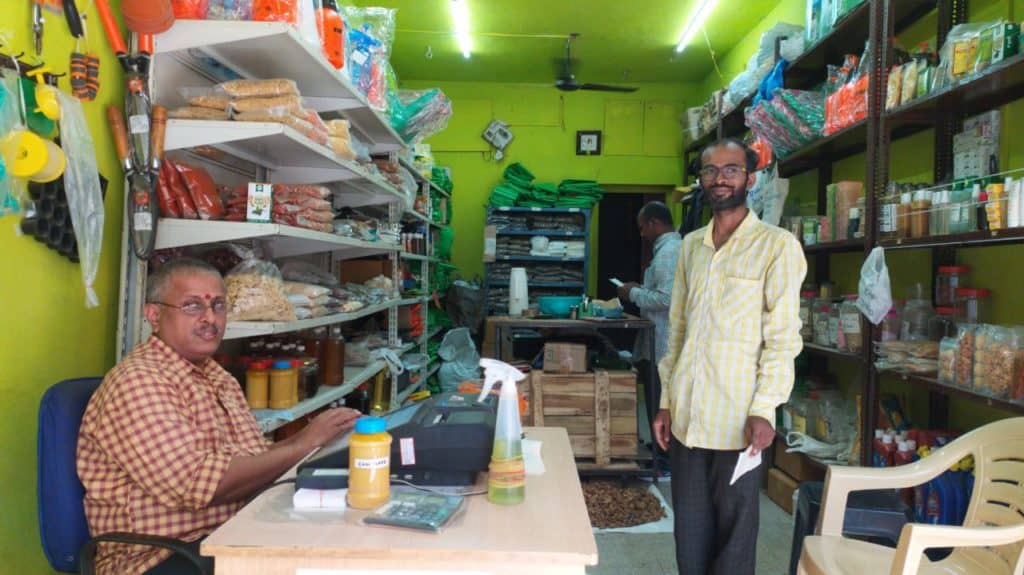“To forget how to dig the earth and tend the soil is to forget ourselves.” — Mohandas Karamchand Gandhi
Suchitra Akella, an ex-employee of HSBC, planted her terrace garden five years ago when she was pregnant with her second child. “Although I had ornamental plants while living in a flat, I was worried about managing the terrace garden,” says Suchitra. “My initial efforts failed many times. Then V S Kumar, Naresh and Shastry from the Rythu Mitra gardening group provided great support. The horticulture department was also helpful. Now, we source fresh produce directly from our terrace vegetable patch at least 4-5 days in a week.”
Sharing a few useful tips for newbie gardeners, Suchitra said, “Basic requirements are sunlight and water, but one should be cautious about overwatering. Mulching is very important to retain moisture. This can be done with dry leaves and twigs or using kitchen waste. Gardeners should focus on mixed crops like vegetables and flowers, especially yellow flowers to attract bees for pollination. Depending on the pot size, they can supplement bio-organic fertilizers with cow-based products like gana jeeva amrutam and panchagavya at regular intervals for better nutrition.”
The twin cities of Hyderabad and Secunderabad have seen a major spurt in urban gardening during COVID times. The lockdown pushed more city dwellers to grow fruit and vegetables in whatever space was available in their homes.
Home Gardening and Urban Agriculture (HGUA) programmes help local communities grow economically, socially and health-wise. According to the Department of Economic and Social Affairs, United Nations (UN) 2018 report, by 2050, 68% of the world’s population is projected to live in urban areas – a sizable increase from the current 55%.
In the same period, it is projected that India will have added 416 million urban dwellers. As per a 2018 study published in the journal Earth’s Future, “Urban agriculture can be crucial to feeding them, potentially producing as much as 180 million tonnes of food a year – or about 10% of the global output of pulses and vegetables.”
The micro climate of Hyderabad is highly suitable for growing both temperate and tropical vegetables, according to the Telangana horticulture department. Hyderabad’s tropical wet and dry climate, with temperatures ranging from 13 to 40 degrees C, and an average rainfall of 89 cm, is conducive to home gardening, as more Hyderabadis are discovering.
Everyone gains
Like Sreedevi Ande, a resident of Gachibowli who works for Microsoft. “I planted fruit trees like gooseberry, banana, pomegranate, etc and arranged a variety of different plants like flowering plants in bedroom balconies,” said Sreedevi. “Over the last six months, we haven’t bought any leafy vegetables, except for coriander. We could sustain in COVID times only because of our urban garden. I told encouraged my friends to start gardening too.”
Urban or home gardening is not new. According to the American Society of Landscape Architects’ (ASLA) ‘The Dirt’ blog, the history of urban agriculture dates back to about 3,500 B.C. It has generally seen a spurt during difficult times like wars and pandemics in the past. During the two world wars, Victory Gardens, war gardens or food gardens for defence as they were called, became highly popular. Vegetables, fruits, and herb gardens were planted extensively in both private residences as well as public parks in the United States, United Kingdom, Canada, Australia and Germany. Eleanor Roosevelt even planted a victory garden on the White House lawn.
In India, growing of Tulsi, curry leaf and other medicinal plants, ornamental flowers like hibiscus and firecracker flowers, and horticulture crops like banana, mango, and coconut in the garden has been commonplace in many homes over centuries.
How much space is needed?
One can set up an urban garden of any size and scale. Whether one wants a landscaped lawn, or grow ornamental flowering plants in one’s balcony, or organic vegetables on the terrace, the possibilities are many. Based on the physical spaces available, be it a small apartment or a sprawling independent house, a gardener has enough flexibility for food production in either indoor spaces or rooftop gardens.
Plants can be grown on a table, in the garden or a nook of the house, on the kitchen sill, or just about anywhere around the house. With numerous plants suitable for home cultivation, terrariums are also possible for gardening enthusiasts. For those with limited spaces, vertical farming is a viable approach. Local community gardens are also becoming a popular choice.
“I started terrace gardening five-and-a-half years ago,” said Sirisha Prabhala, a techie who has worked with Microsoft and Infosys. “We had moved to an independent house and there was space and time to start a small garden. And as I was on a work break because of my two young kids, I was looking to pick up a hobby.”
But gardening does need a fair amount of time and effort. Though cost need not be a deterrent, lack of patience can be. “Learn and take someone as inspiration, don’t give up,” advises Suchitra.
“It took me three years to grow my garden to its current state,” added Sirisha. “During COVID, we were able to harvest 400-450 mangoes from a single tree.”
Government support/subsidy
“Cultivation of vegetables, leafy vegetables and flowers in a radius of 50-70 km around Hyderabad would be a priority, as these areas have easy access to markets,” said S Niranjan Reddy, Minister for Agriculture, in an interaction with local media.
Keeping in view the increasing population and cost of vegetables, the Telangana Department of Horticulture had introduced an annual scheme in 2012-13 to provide quality and pesticide residue-free hybrid seeds, vegetable mini kits etc. to city residents.
Rashtriya Krishi Vikas Yojana (RKVY), a scheme with a 60:40 funding pattern by centre and state government respectively, also aims to educate on the benefits of integration of different agricultural practices like shade netting, plastic mulching and micro irrigation for increased vegetable production.
Why is urban gardening the future?
In a detailed project report of the Rashtriya Krishi Vikas Yojana, titled Raftar 2020, the Telangana Horticulture Department points out, “One third of the population of Telangana State stays in and around Hyderabad city, creating huge and continuous demand for supply of vegetables. Urbanization is one of the major constraints in expansion of the vegetable area.”
Urban gardening also seeks to minimize the carbon footprint associated with mass production, by localizing produce supply. It helps reduce the amount spent on purchasing vegetables and fruits and adds to the biodiversity by encouraging birds and insects to flourish. It can also nurture people’s social skills.
As per the Telangana Horticulture Department, “Hyderabad rooftops have an area of 60,000 square metres approximately. If 50% of this area is converted into rooftop gardens, shortages and health issues can both be overcome.”
According to a Food and Agriculture Organization (FAO) report, urban garden land is 15 times more productive than the rural holdings. The study further noted that one square meter of urban farm is capable of producing 36 heads of lettuce every 60 days, 10 cabbages every 90 days and 100 onions every 120 days.
‘Green roofs’ is one of the key solutions to make urban settlements more sustainable. While reducing one’s isolation from nature, the COVID pandemic has highlighted its contribution to the food security of city dwellers.
What’s supporting urban farming groups in Hyderabad?
In addition to multifold online resources, several voluntary groups like Rythu Mitra came into existence out of a passion for natural farming. What began as a Facebook Group more than five years ago, Rythu Mitra is now into distributing free desi seeds and Jeevamrutham and organising plant-swapping meetings for city-dwellers and farmers alike.
“It has been a fascinating journey, not only for urban gardeners, but also for our farmer commune who gave up using chemical fertilisers, and our customers who have now become good gardeners,” said V S Kumar, Rythu Mitra Co-Founder.
In his words, “Inspired by the ‘Inti Panta’ group on social media, we started ‘Rythu Mitra’ in Visakhapatnam. Our aim is to promote pesticide-free farming. Naganada Rai Kanti, took the initiative of starting an outlet on Nizampet Road, Hyderabad. We are inundated with requests from people, asking for suggestions on soil and gardening tips (helpline numbers 8885053019 and 9381172615). We are also creating broadcast groups to educate, clarify doubts, take orders, share estimates and regular tips to control pests, etc. So far, we have created 20 broadcast groups and are planning another seven to reach enthusiastic gardeners and share our knowledge with them. It’s a completely free service.”
The horticulture department too organises frequent melas and horticulture expos in the city. They are also encouraging gardening enthusiasts by awarding them certificates.
Initiated in 2012, a private five-day annual All India Horticulture Agriculture & Nursery Expo is organized at Necklace Road in January/February. It is quite a popular event with gardening enthusiasts and newbie gardeners. With over 100 stalls, it is a one-stop destination for all gardening needs. From a plant costing 30 rupees plant to a bonsai worth a whopping 3 lakh rupees, the expo offers enough options to suit every budget.
For more serious and large-scale horticulture enthusiasts, events like International Horti Expo held at HITEX Exhibition Centre is another resource to learn about and source gardening-related products. The International Horti Expo 2020 series, which is one of India’s largest exhibitions on horticulture products, farm machinery, processing & post-harvest technologies is supported by the Ministry of Agriculture and its departments, Mission for Integrated Development of Horticulture (MIDH), National Horticulture Board, National Centre for Cold-chain Development, and National Mission for Micro Irrigation.
Also read:
- A garden on every roof: Help the Patchai Madi project turn Chennai into India’s urban farming capital (citizenmatters.in)
- Greening rooftops: 10 ideas from Chennaiites (citizenmatters.in)
Reference reading: NatuEco’ is an environment and farmer friendly, low-cost biological option, which combines two words, “Natural” and “Ecological” to go Beyond Organic Farming. Details available in Prof Dabholkar’s book, “Plenty for All”.
Image Source: Lal, R. Home gardening and urban agriculture for advancing food and nutritional security in response to the COVID-19 pandemic. Food Sec. 12, 871–876 (2020). https://doi.org/10.1007/s12571-020-01058-3




Want to learn gardening
Good initiative. Me too interested
Yes
I need tips to cultivate terrace gardening,with low cost. Free space available in my ground garden, but no longer using for cultivating due to no proper minerals in that soil. Thank you.
I do have a terrace and we are interested in starting our own terrace garden, we need guidance in how to start one
I am interested in urban gardening
Good initiative loving it need help pls
Very interesting about roof garden.I have also started roof garden on a small scale.I request organizers to give me tips ,seeds &fruity plants for developing my roof gaeden.
I want to learn gardening
Little free space is available on the ground and free space is available on terrace. Need tips for proper gardening.